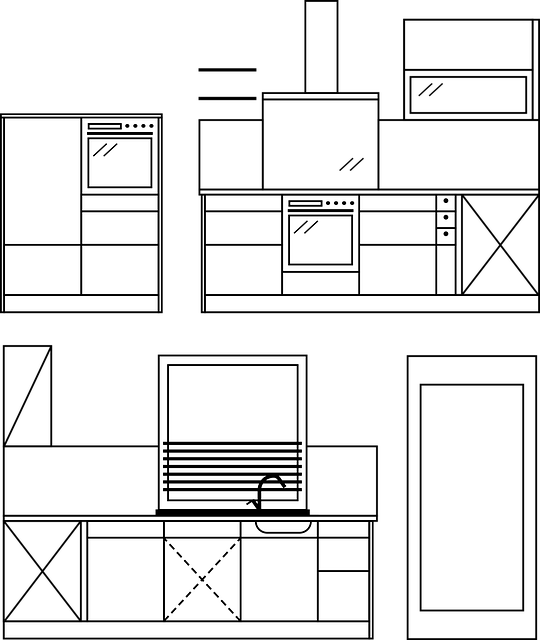GE Microwave Maintenance: Fixing Common Problems and Prevention Tips
If your GE microwave isn't working, start with basic troubleshooting like checking its power co…….

If your GE microwave isn't working, start with basic troubleshooting like checking its power connection, inspecting the circuit breaker, or cleaning the turntable for smooth operation. Common issues like uneven heating might indicate a problem with the magnetron, which may need to be replaced. If the keypad is unresponsive, it could be due to loose connections or power surges; try resetting the microwave first. Any burning smell not accompanied by cooking food is an emergency and requires immediate professional intervention to prevent fire hazards. Regular maintenance, including cleaning after each use, inspecting and replacing the door seal, and safe cleaning practices, will help maintain your microwave's performance and longevity. For complex problems or when in doubt, consult a certified technician for safety reasons. Remember to handle all repairs with caution, adhering to the user manual for specific guidance on your model. Always prioritize safety over function when repairing or maintaining your appliance.
When it comes to culinary appliances, a GE microwave stands as a cornerstone for kitchen convenience. Ensuring its functionality is paramount not only for the myriad recipes it enables but also for the daily routine it streamlines. This article delves into the common issues that can arise with GE microwaves and provides a comprehensive guide to troubleshoot and resolve them effectively. By understanding the intricacies of your GE microwave, you’ll be equipped to maintain its performance and uphold the comfort it brings to meal preparation. Beyond repair, we’ll also offer valuable tips to safeguard against future malfunctions, ensuring your kitchen companion remains reliable for years to come.
- Troubleshooting Common GE Microwave Issues
- Step-by-Step Repair Guide for GE Microwaves
- Tips to Prevent Future GE Microwave Repairs
Troubleshooting Common GE Microwave Issues

When your GE microwave is on the fritz, troubleshooting common issues can help you resolve the problem without resorting to a costly repair service. A frequent concern is when the microwave fails to turn on at all. Before diagnosing a power issue, ensure that the appliance is plugged in securely and that the circuit breaker or fuse hasn’t tripped. If the microwave powers on but isn’t heating, check if the turntable is obstructed, as this can prevent proper operation. Clean any food debris from the turntable and surrounding areas, as a dirty microwave can malfunction. Should the microwave be heating unevenly or not at all, inspect the magnetron, which generates the microwaves. If it’s damaged or faulty, replacement may be necessary. Another common issue is when the keypad becomes unresponsive. This could be due to a loose connection or a power surge. In such cases, resetting the microwave can often restore functionality. Lastly, if your GE microwave is emitting a burning smell without any food source, this indicates a serious problem and should prompt immediate unplugging of the appliance to avoid fire hazards. It’s crucial to address this issue with a qualified technician before attempting to use it again. Regular maintenance and timely troubleshooting can keep your GE microwave in optimal working condition, ensuring convenience in your kitchen for years to come.
Step-by-Step Repair Guide for GE Microwaves

When your GE microwave isn’t functioning as expected, a step-by-step repair guide can help you troubleshoot and resolve common issues, allowing you to maintain the convenience of quick meals in your kitchen. Before attempting any repairs, ensure you have the necessary safety equipment like gloves and eyewear, and consult the user manual for specific model instructions.
To start with, if your microwave is not turning on, first check that it’s plugged in properly and that the circuit breaker hasn’t tripped. If the microwave powers on but isn’t heating, inspect the high-voltage cap and resistor package, which can sometimes overheat and cause a breakdown in operation. Locate these components behind the turntable assembly or on the high-voltage cable. If the interior light is not working, check the bulb and its socket for any signs of damage or loose connections.
Next, if your GE microwave’s keypad is unresponsive, gently clean the contacts with a soft brush or compressed air to remove any food debris. Should the turntable spin erratically or not at all, inspect and tighten the mounting screws, and verify that the motor and drive gear are functioning by listening for proper operation sounds and ensuring smooth rotation.
For issues involving the microwave’s display or time functions, check the control board for faults or disconnections. If the microwave is leaking or showing signs of overheating, shut it off immediately and unplug it, as this indicates a potentially dangerous electrical issue that requires professional attention.
In case of a sparking interior during operation, stop using the appliance, unplug it, and inspect the high-voltage transformer and diodes for damage. If you’re not comfortable performing these steps or if the problem persists after initial troubleshooting, it’s advisable to contact a certified technician to handle the repair safely and effectively. Remember, safety is paramount when working with household appliances.
Tips to Prevent Future GE Microwave Repairs

1. Regular maintenance is key to preventing costly repairs on your GE microwave. Start by keeping the interior clean to prevent food particles from causing odors or affecting the microwave’s performance. Use a soft cloth dampened with vinegar to wipe down the interior, and avoid using abrasive cleaners that can damage the surface. Additionally, inspect the door seal for wear and tear regularly; a compromised seal can lead to power issues and prevent the microwave from operating efficiently. For safety, always ensure the microwave is unplugged or turned off before cleaning.
2. To maintain your GE microwave’s longevity, be mindful of proper usage practices. Avoid overloading the microwave with too much food at once, as this can cause it to work harder and potentially fail prematurely. Use microwave-safe containers and avoid heating foods for extended periods beyond what is necessary, as this can strain the microwave’s components. Regularly check the turntable for any damage or obstruction, as its movement is essential for even cooking. If it becomes stuck or broken, replace it to maintain performance. Lastly, keep your microwave away from heat sources and direct sunlight, as extreme temperatures can affect its operation and shorten its lifespan. By following these preventative measures, you can minimize the likelihood of future repairs and enjoy consistent kitchen convenience with your GE microwave.
Maintaining a well-functioning kitchen appliance like a GE microwave is key to the convenience and efficiency of your daily cooking tasks. By understanding common issues, following a detailed repair guide tailored for GE models, and adopting preventive maintenance tips, you can ensure your microwave remains reliable over time. Regular upkeep and awareness of potential problems allow for swift resolutions, minimizing disruptions to your culinary routine. With these tools at your disposal, you’re well-equipped to handle any minor repairs that may arise, thus preserving the convenience your GE microwave offers in the kitchen.







